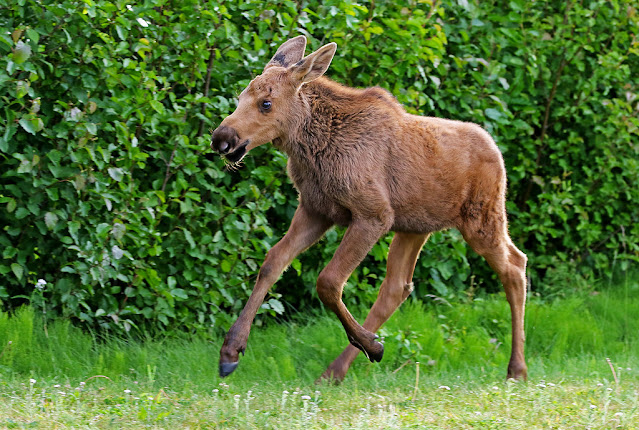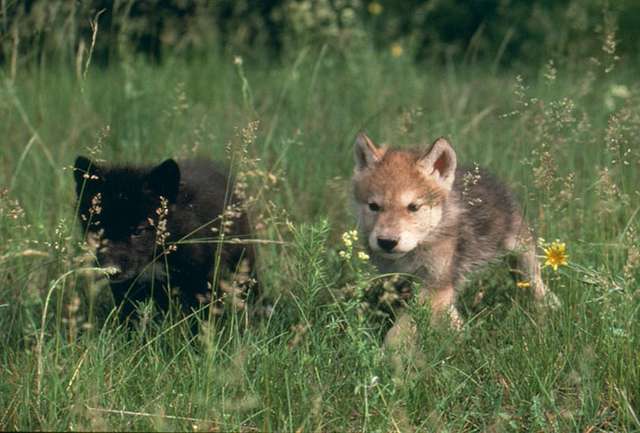Yellowstone National Park provides an amazing opportunity to witness some incredible wildlife living free in their natural environment. While any animal sighting makes for a memorable experience how wonderful would it be to be lucky enough to see some cute babies during a visit to the park. Here is a rundown of when baby animals normally can be spotted in the Cody Yellowstone region that includes a large swath of the national park and the Northwest Wyoming communities of Cody, Meeteetse, and Powell:
- Bison calves are often the first of the young ones to make their debut. Reddish-colored, fuzzy-furred bison calves are quick studies, and they can keep up with their mothers as soon as two hours after birth. It takes a village to protect a bison calf, and all adult bison surround young calves when predators such as wolves and bears are nearby. You’ll often hear these calves referred to as red dogs because of their orange-red color.
- Black bear cubs are born during the winter, and they spend the first couple of months of their lives nursing and dozing while their semiconscious mamas continue to slumber in their dens. The bear cubs finally see daylight around the month of April. Mothers spend the next 16 to 18 months teaching their babies how to survive in the wild.
- Moose cows aren’t quite as patient with their young. Once they give birth to a new calf – typically in May or June – they chase away the previous season’s calves. While not known for their intelligence, moose are predictably unpredictable, particularly when protecting a calf. Moose cows will chase human observers and other wildlife if they perceive a threat. Moose are frequently spotted near the Northeast and East entrances to Yellowstone.
- Bighorn sheep produce one or two lambs annually. Born in May or June, the lambs immediately begin the multi-year process of growing their horns. For this species, size matters. The horns on male Rocky Mountain bighorn sheep can weigh as much as 40 pounds, and the size of horns can influence a ram’s rank in the herd.
- Elk thrive throughout the region, particularly in East Yellowstone Valley along the North Fork of the Shoshone River. Usually born in late May and June, elk calves like most ungulates can walk within an hour or two of birth. An elk cow’s protective strategy when predators are near is to run away in hopes the predator will follow her and not notice the newborn lying motionless in the grass.
- Wolf pups begin appearing in April and May, and their packs will remain with them for three to 10 weeks as they learn bit by bit how to be a wolf in Yellowstone. Their playful antics with their littermates make wolf-watching in spring especially fun. While wolves roam throughout the Greater Yellowstone region, the best sightings are often in the Lamar Valley inside the park.
- River otters are also born with an entertainer’s spirit, but they are a little harder to spot. Born in March and April, these aquatic nomads stay with their moms for a year as they learn how to find fish and other food and swim underwater for minutes at a time.
- Eagles emerge in mid-April and fly from their nests three to four months after that. This remarkable once-endangered bird is one of 19 raptor species in the park. Northwestern Wyoming is home to bald eagles and golden eagles. Bald eagles feed on fish, and their nests can often be found in trees close to water. Golden eagles are more frequently spotted in valleys where they can accommodate their preference for rabbits and other small mammals.
Wildlife can be unpredictable at any time, but especially if they are protecting their young. National Park Service wildlife watching guidelines can be found here. Here are some tips for safe spring wildlife viewing:
- Keep your distance from wildlife and humans alike. The National Park Service recommends staying at least 100 yards away from bears and wolves and 25 yards from other wildlife.
- Drive carefully and keep and binoculars handy. Throughout the spring, visitors are almost as likely to see wildlife like bighorn sheep lambs along the Buffalo Bill Scenic Byway – the 52-mile road to the East Gate of Yellowstone National Park – as they are inside the park.
- Use pullouts. There are numerous places to pull off the main roads inside and outside the park. Never stop in the middle of the road.
- Early morning and dusk are the best times of the day to spot animals in the wild.
- Bison jams happen. Bison survive the harsh Yellowstone winter by avoiding unnecessary exertion, and that frequently means that herds will lumber down paved, cleared roads instead of through deep snow. Lucky travelers who encounter a so-called bison jam should savor the up-close view of these mighty creatures as they slowly pass stalled traffic. Visitors should stay in their vehicles, keep windows rolled up and not try to touch or speed up the animals.
- Never feed the wildlife.
- Know where you’re going. Visit the Cody Visitor Center for maps and other information about the region.





No comments:
Post a Comment